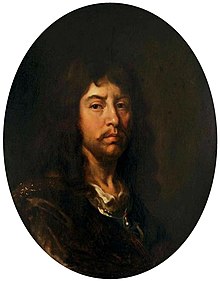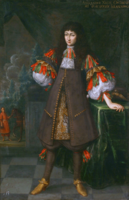| Andreas Stech | |
|---|---|
 Self-portrait. circa 1675 Self-portrait. circa 1675 | |
| Born | Andreas Stech (1635-09-09)9 September 1635 Stolp, Duchy of Pomerania, Holy Roman Empire (modern Słupsk, Poland) |
| Died | 12 January 1697(1697-01-12) (aged 61) Danzig, (Gdańsk) |
| Known for | Painting |
| Movement | Baroque |
| Spouse | Adelgunde Wulf |
Andreas Stech (September 9, 1635 – January 12, 1697) was a Baroque painter.
Stech was born in Stolp (Słupsk), the son of Heinrich Stech a painter from Lübeck. He was of Lutheran faith. In 1636, together with his family he moved to Danzig (Gdańsk). It is most likely that he was taught by his father; from 1653, by his father-in-law Adolf Boy (1612-1683). In 1658, he married the widow of the painter August Ranisch. After the death of his first wife, he married Adelgunde, the daughter of Nicias Wulf. He had five children from his first marriage, and four from his second. In 1662, he became the Master Artisan on the basis of his artwork: The Calling of St. Andrew and Croesus throwing himself in the fire. In 1667, he received Danzig citizenship. In 1673, he became a juror. From 1677, he worked for King John III Sobieski of the Polish–Lithuanian Commonwealth. His brother was also a painter.
-
 Portrait of Heinrich Schwarzwaldt
Portrait of Heinrich Schwarzwaldt
(1682) -
 Portrait of a Patrician Lady from Danzig
Portrait of a Patrician Lady from Danzig
(1685) -
 Portrait of a townsman from Danzig
Portrait of a townsman from Danzig
(1675) -
 Portrait of Zasławski-Ostrogski
Portrait of Zasławski-Ostrogski
(1670)
References
- "Biography". Antykwariat Kwadryga. Retrieved 22 October 2015.
- Adam, Wolfgang; Westphal, Siegrid (6 December 2012). Handbuch der kulturellen Zentren der frühen Neuzeit. p. 306. ISBN 9783110295559.
- biography of Andreas Stech
- "Andrzej Stech Biography". Culture. Retrieved 22 October 2015.
- "Andrzej Stech Paintings". Pinakoteka. Retrieved 22 October 2015.
External links
![]() Media related to Andreas Stech at Wikimedia Commons
Media related to Andreas Stech at Wikimedia Commons